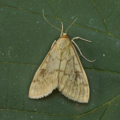2022 Annual Report for: Crambidae / Pyraustinae
For species seen in 2022 that had less than or equal to 100 records, full details are included; for more common species, the earliest, latest and highest count by vice-county are shown. The narrative for each species is taken from the main Hantsmoths website, and it is possible that some information on abundance and occurrence can get out of date, as it is impossible to keep up with all changes; however it should give a good introduction to each species. The tables in each species account summarise the previous status, and that for the current year.
For the maps, all records prior to 2022 are shown by a blue dot (the larger the dot, the more recent), with the current year's records shown in red. As previous records are superimposed on any report for 2022, new sites have greater emphasis (i.e. will show as 'more red').
In the species accounts, an asterisk next to a location indicates a new 10km square record; earliest ever dates are highlighted in orange, and latest ever in red. Initials in the species accounts refer to the recorders listed here. Please get in touch if you identify any omissions or errors, in particular if you have records that have yet to be submitted. Details of how to submit records can be found here.
63.002 [B&F: 1368] Loxostege sticticalis (Linnaeus, 1761) - Migrant
Irregular immigrant to the British Isles from southern Europe, common in some years. In Hampshire and on the Isle of Wight most frequent on the coast, but very irregular in appearance, with a notable influx in 1995 when at least 12 were recorded. Most common in the south, where it is nearly annual, reports from the north are very rare, with only four to date: one in 2022 was the first for 21 years (five individuals were reported in VC12). Wingspan 24-29 mm. Most likely to be confused with the abundant Udea olivalis, but distinguished by the characteristic white terminal streak. Larva feeds on Mugwort, over-wintering as a pupa.
Records prior to 2022
| Vice County | #Records | #Individuals | First Record | Last Record |
|---|---|---|---|---|
| 10 | 15 | 13 | 1856 | 2021 |
| 11 | 17 | 15 | 1955 | 2017 |
| 12 | 3 | 3 | 1970 | 2001 |
2022 records
| Vice County | #Records | #Individuals | Max Quantity |
|---|---|---|---|
| 11 | 6 | 6 | 1 |
| 12 | 1 | 1 | 1 |

Records by year
Records by week (adult)
Records by week (larval)
Record Details
VC11: Woodlands, NF*, one, 19 Jul (RBW); Fareham, one, 12 Jul (MLO det. KJW); The Hangers, Bishops Waltham*, one, 06 Aug (SIng); Portchester, one, 05 Sep (DAS); Lovedean*, one, 24 Jul (ARJ); Petersfield Heath, Petersfield*, one, field observation, 11 Sep (RAll);
VC12: Ecchinswell*, one, 12 Sep (MJN)
63.003 [B&F: 1367] Pyrausta cingulata (Linnaeus, 1758) - Nationally Scarce B
Nationally scarce (Nb). Local, on chalky ground and sand-dunes, mainly on the coast, throughout much of England, Wales and southern Scotland, and in parts of Ireland. In Hampshire and on the Isle of Wight known principally from West Wight; records from the mainland should be treated with caution. Wingspan 14-17mm. Distinguished from P. nigrata by larger size and straighter white cross-lines on the forewing. Larva feeds on Wild Thyme, living within a spinning.
Records prior to 2022
| Vice County | #Records | #Individuals | First Record | Last Record |
|---|---|---|---|---|
| 10 | 59 | 131 | 1856 | 2021 |
| 11 | 1 | 0 | 1951 | 1951 |
2022 records
| Vice County | #Records | #Individuals | Max Quantity |
|---|---|---|---|
| 10 | 1 | 1 | 1 |
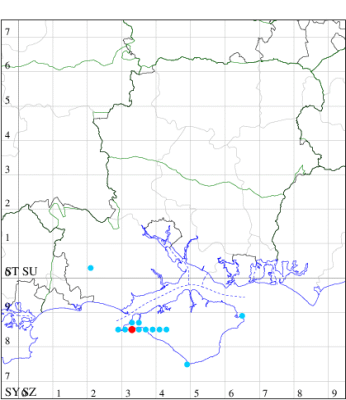
Records by year
Records by week (adult)
Records by week (larval)
Record Details
VC10: West High Down quarries, one, 12 Jul (IOu)
63.005 [B&F: 1365] Pyrausta despicata (Scopoli, 1763) - Common
Local, on sand-dunes, dry heathland, downland and open areas on chalk or limestone, throughout the British Isles. Widespread in Hampshire and Wight. Wingspan 14-19mm. Forewing more mottled and less clearly marked than in any other British Pyrausta species [Goater]. Flies both by day and night. Larva feeds on Ribwort and Greater Plantain, forming silken galleries.
Records prior to 2022
| Vice County | #Records | #Individuals | First Record | Last Record |
|---|---|---|---|---|
| 10 | 245 | 492 | 1856 | 2021 |
| 11 | 778 | 2069 | 1951 | 2021 |
| 12 | 234 | 330 | 1951 | 2021 |
2022 records
| Vice County | #Records | #Individuals | Max Quantity |
|---|---|---|---|
| 10 | 46 | 81 | 6 |
| 11 | 85 | 131 | 10 |
| 12 | 24 | 36 | 7 |

Records by year
Records by week (adult)
Records by week (larval)
Record Summary
VC10: Earliest: Bonchurch Down, 14 Apr, 4 (IOu) Latest: Freshwater Bay, 14 Sep, 1 (PBar) Max count: Bonchurch, 24 Aug, 6 (JHa)
VC11: Earliest: West Walk, 22 Apr, 1 (RJD, MLO, ADT, DWal, KJW) Latest: Romsey, 12 Sep, 1 (KPea) Max count: Needs Ore NNR, 11 Aug, 10 (CNB)
VC12: Earliest: Noar Hill HIWWT NR, 02 May, 1 (DAS) Latest: Chilbolton, 01 Nov, 1 (GCE) Max count: Morn Hill, Winchester, 13 Aug, 7 (CRB, DAS, PDF et al)
63.006 [B&F: 1361] Pyrausta aurata (Scopoli, 1763) - Common
Local, on chalk downland and open, grassy areas, discontinuously throughout much of England, Wales and southern Scotland. In Hampshire and on the Isle of Wight, sometimes abundant on the downs, but also in gardens amongst cultivated mint. Wingspan 15-18mm. Flies by day and night. The main confusion species is P. purpuralis which is larger and occurs less frequently in gardens. P. aurata has fewer cream spots on the forewing and the spot near the dorsal edge is either absent or small and broken into three parts. P. purpuralis has a rounded leading edge to the dorsal cream spot. Note that the purple scales apparent when freshly emerged quickly wear off and leave just a brown appearance. Larva feeds on Mint, Marjoram and Thyme, living within a silken tube or tent.
Records prior to 2022
| Vice County | #Records | #Individuals | First Record | Last Record |
|---|---|---|---|---|
| 10 | 401 | 668 | 1856 | 2021 |
| 11 | 4980 | 9660 | 1951 | 2021 |
| 12 | 2209 | 5324 | 1951 | 2021 |
2022 records
| Vice County | #Records | #Individuals | Max Quantity |
|---|---|---|---|
| 10 | 45 | 58 | 7 |
| 11 | 431 | 1297 | 22 |
| 12 | 183 | 456 | 100 |

Records by year
Records by week (adult)
Records by week (larval)
Record Summary
VC10: Earliest: Cowes, 24 Apr, 1 (DNor) Latest: Newport, 12 Sep, 1 (DPl) Max count: Brading Down LNR, 01 Aug, 7 (JRB)
VC11: Earliest: Totton, 23 Apr, 1 (LHan) Latest: Pennington, 04 Oct, 1 (RFC) Max count: Totton, 11 Aug, 22 (LHan)
VC12: Earliest: Magdalen Hill Down NR, 10 Apr, 1 (LHur) Latest: Basingstoke, 21 Sep, 1 (MJW) Max count: Stockbridge Down, 22 Jul, 100 (CKni)
63.007 [B&F: 1362] Pyrausta purpuralis (Linnaeus, 1758) - Common
Found on chalk downland and dry, grassy areas, throughout much of Britain favouring very short turf. In Hampshire and on the Isle of Wight, locally common on the downs, and sometimes found in gardens where Thyme is grown. Wingspan 15-22mm. Flies by day and night. At first glance, confusable with P. aurata, from which distinguished by its larger size and the rounded leading edge to the dorsal cream spot on the forewing. The hindwing always has one or two yellow spots or short, broad streaks; this is best seen by viewing the underside of the moth. Also see the very similar P. ostrinalis for differences. Note that the purple scales apparent when freshly emerged quickly wear off and leave just a brown appearance. Larva feeds on Wild Thyme and Large Thyme and sometimes Corn Mint, living within a silken tube or tent.
Records prior to 2022
| Vice County | #Records | #Individuals | First Record | Last Record |
|---|---|---|---|---|
| 10 | 149 | 427 | 1856 | 2021 |
| 11 | 1305 | 1849 | 1951 | 2021 |
| 12 | 517 | 852 | 1951 | 2021 |
2022 records
| Vice County | #Records | #Individuals | Max Quantity |
|---|---|---|---|
| 10 | 12 | 17 | 5 |
| 11 | 127 | 166 | 7 |
| 12 | 28 | 34 | 5 |

Records by year
Records by week (adult)
Records by week (larval)
Record Summary
VC10: Earliest: Arreton Down, 17 May, 1 (IOu) Latest: Totland, 01 Sep, 1 (RTer) Max count: West High Down quarries, 12 Jul, 5 (IOu)
VC11: Earliest: Totton, 21 May, 1 (LHan) Latest: Broughton Down HIWWT NR, 12 Sep, 1 (BHed) Max count: Buttsash, Hythe, 22 Jul, 7 (JBl)
VC12: Earliest: Noar Hill HIWWT NNR, 21 Apr, 1 (BGD) Latest: Cole Henley, 22 Sep, 1 (GCE) Max count: Tidgrove Warren, nr Overton, 23 Jul, 5 (MJW, ACB)
63.008 [B&F: 1363] Pyrausta ostrinalis (Hübner, 1796) - Nationally Scarce B
Local, in dry grassland and on chalk downland, throughout much of Britain. In Hampshire and on the Isle of Wight, very scarce on short chalk downland turf, and found in numbers only in West Wight. Wingspan 15-21mm. Markings very similar to those of P. purpuralis but when fresh has a subtly pinker colour to the forewing which is narrower and has a slightly concave leading edge. The cream spots markings are generally linked together and edged with black. The least subjective criteria can be found on the underside of the wing, viewable best on a set specimen but also on the live moth in a clear container: the pale subterminal line in P.purpuralis is nearly straight and fades before the costa, whereas in the present species it curves to meet the postmedian line at the costa (see British Pyralid Moths, Goater 1986 p.67 for illustration). The larva feeds on Wild Thyme. A good photograph or specimen is required for records of this species to be accepted.
Records prior to 2022
| Vice County | #Records | #Individuals | First Record | Last Record |
|---|---|---|---|---|
| 10 | 91 | 415 | 1856 | 2021 |
| 11 | 26 | 9 | 1947 | 2018 |
| 12 | 25 | 39 | 1971 | 2012 |
2022 records
| Vice County | #Records | #Individuals | Max Quantity |
|---|---|---|---|
| 10 | 3 | 6 | 4 |

Records by year
Records by week (adult)
Records by week (larval)
Record Details
VC10: West High Down quarries, one, 12 Jul; East Afton Down, one, field observation, 24 Apr; Mottistone Down, four, field observation, 01 Jul (IOu)
63.009 [B&F: 1366] Pyrausta nigrata (Scopoli, 1763) - Local
Local, on chalk downland and limestone pavements, throughout much of southern England and in the Lake District. In Hampshire found locally on the downs. On the Isle of Wight, recorded only occasionally in recent years after an absence of over a century. Wingspan 14-17mm. Identified by the combination of black wings with white fringes and angled cross-lines. Larva feeds on Wild Thyme, Wild Marjoram and Corn Mint, living between leaves spun together with silk, over-wintering as a pupa
Records prior to 2022
| Vice County | #Records | #Individuals | First Record | Last Record |
|---|---|---|---|---|
| 10 | 7 | 15 | 1900 | 2007 |
| 11 | 129 | 205 | 1951 | 2021 |
| 12 | 145 | 231 | 1951 | 2021 |
2022 records
| Vice County | #Records | #Individuals | Max Quantity |
|---|---|---|---|
| 12 | 4 | 4 | 2 |

Records by year
Records by week (adult)
Records by week (larval)
Record Details
VC12: Cholderton, two, 19 Jul (TJN); Stockbridge Down, one, field observation, 22 Jul (CKni); one, field observation, 18 Apr (JSol); Noar Hill HIWWT NR, Selborne, present, field observation, 26 Apr (RAng)
63.011 [B&F: 1369] Uresiphita gilvata (Fabricius, 1794) - Migrant
Rare immigrant to southern and western England from southern Europe. In Hampshire and on the Isle of Wight irregular in appearance, mainly on or near to the coast, occurring on average no more than once or twice every five years, but 2013 saw at least six individuals recorded. Wingspan 29-37 mm. Hindwing orange-yellow with blackish border, a feature which renders the species unmistakable [Goater]. Larva feeds on herbaceous plants, no evidence of breeding in the UK.
Records prior to 2022
| Vice County | #Records | #Individuals | First Record | Last Record |
|---|---|---|---|---|
| 10 | 16 | 18 | 1959 | 2013 |
| 11 | 7 | 7 | 1966 | 2013 |
| 12 | 2 | 2 | 1967 | 1978 |
2022 records
| Vice County | #Records | #Individuals | Max Quantity |
|---|---|---|---|
| 10 | 3 | 4 | 2 |
| 11 | 5 | 5 | 1 |

Records by year
Records by week (adult)
Records by week (larval)
Record Details
VC10: Bonchurch, one, 27 Oct (JHa); Shanklin, two, rare migrant moth. First IW record since 2013, 25 Oct; one, 30 Oct (IOu);
VC11: Romsey*, one, 27 Oct (MJB); Dibden Purlieu*, one, 29 Oct (RAC); Buttsash, Hythe*, one, 26 Oct (JBl); Fareham, one, 28 Oct (IMcP); New Milton, one, 27 Oct (RPH)
63.013 [B&F: 1387] Nascia cilialis (Hübner, 1796) - Nationally Scarce B
Nationally scarce (Nb) in marshes and fens and along freshwater margins in the Cambridgeshire fens and, very locally, in Hampshire. In Hampshire still regular in and around Titchfield Haven, with occasional wanderers elsewhere; recently found in the Afton Marsh area of the Isle of Wight and undoubtedly now resident there. Wingspan 24-27 mm. An easily recognised species, though it could conceivably be confused with the scarce immigrant Antigastra catalaunalis [Goater]. Larva feeds on Greater Pond-sedge
Records prior to 2022
| Vice County | #Records | #Individuals | First Record | Last Record |
|---|---|---|---|---|
| 10 | 14 | 20 | 2003 | 2019 |
| 11 | 40 | 111 | 1971 | 2021 |
2022 records
| Vice County | #Records | #Individuals | Max Quantity |
|---|---|---|---|
| 11 | 2 | 2 | 1 |

Records by year
Records by week (adult)
Records by week (larval)
Record Details
VC11: Furzehill, NF*, one, 03 Aug (SLoa det. AMD); Wickham*, one, 26 May (JRDS); Gosport*, one, 20 Jun (KIls)
63.014 [B&F: 1370] Sitochroa palealis ([Denis & Schiffermüller], 1775) - Local
Local on heathland, downland, waste ground and cliff-tops throughout much of southern England and East Anglia. In Hampshire and on the Isle of Wight an immigrant which has become established; since 1990, singletons have been seen regularly, and breeding colonies are established, perhaps temporarily, in several localities on the coast and across the chalk downland. Wingspan 29-34 mm. Fairly unmistakable: pale sulphur-yellow when fresh, fading whiter with age, but always with prominent veins. Larva feeds on flowers and seeds of Fennel, Wild Carrot, Pepper-saxifrage, Hogweed and other umbellifers.
Records prior to 2022
| Vice County | #Records | #Individuals | First Record | Last Record |
|---|---|---|---|---|
| 10 | 42 | 19 | 1856 | 2021 |
| 11 | 411 | 482 | 1949 | 2021 |
| 12 | 75 | 67 | 1951 | 2021 |
2022 records
| Vice County | #Records | #Individuals | Max Quantity |
|---|---|---|---|
| 10 | 3 | 3 | 1 |
| 11 | 20 | 20 | 2 |
| 12 | 2 | 2 | 1 |
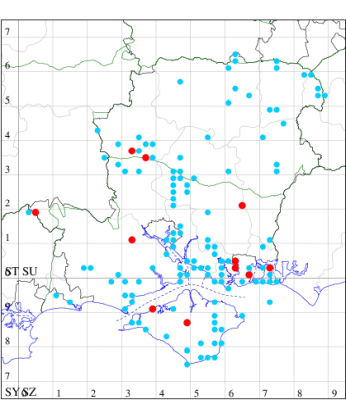
Records by year
Records by week (adult)
Records by week (larval)
Record Details
VC10: Bouldnor, one, field observation, 12 Jul; one, field observation, 12 Jul (JRB); Mount Joy Cemetery, Newport, one, field observation, 23 Jul (KShw det. GShe);
VC11: Woodlands, NF*, present, 21 Jul (RBW); Portchester, one, 18 Jul (DH-J det. MJW); Horsea Island, one, 22 Jul (RJD, MLO, ADT, DWal, KJW); Portsmouth, two, 08 Jul; one, 09 Jul; two, 12 Jul; one, 13 Jul; one, 15 Jul; one, 18 Jul; one, 22 Jul; two, 26 Jul; one, 29 Jul; one, 01 Aug; one, 03 Aug; one, 07 Aug; one, 10 Aug (IRT); Old Winchester Hill, one, 05 Aug (RJD, MLO, ADT, DWal, KJW det. RJD); Northney, Hayling Island, present, 19 Jul; present, 09 Aug (JWP);
VC12: Longstock, one, 18 Aug (GCE); Stockbridge Down, one, field observation, 22 Jul (CKni)
63.016 [B&F: 1386] Anania fuscalis ([Denis & Schiffermüller], 1775) - Local
Local in open woodland, moorland and damp meadows throughout much of Britain. In Hampshire and on the Isle of Wight locally common on downland amongst Yellow Rattle and less so in acid woodland where the foodplant is Common Cow-wheat, and occasional elsewhere. Wingspan 20-26 mm. The most likely confusion species is Algedonia terrealis, which see for differences. Larva feeds on Yellow-rattle and Common Cow-wheat.
Records prior to 2022
| Vice County | #Records | #Individuals | First Record | Last Record |
|---|---|---|---|---|
| 10 | 30 | 55 | 1856 | 2021 |
| 11 | 176 | 255 | 1951 | 2021 |
| 12 | 160 | 1944 | 1951 | 2021 |
2022 records
| Vice County | #Records | #Individuals | Max Quantity |
|---|---|---|---|
| 10 | 3 | 3 | 1 |
| 11 | 4 | 7 | 2 |
| 12 | 13 | 143 | 50 |

Records by year
Records by week (adult)
Records by week (larval)
Record Details
VC10: Ventnor, one, Confirmed by dissection. Extraordinary date, so perhaps a 2nd brood or an immigrant, 27 Oct (MGT); Shanklin, one, field observation, 16 Jun; Osborne Valley Walk*, one, 09 May (IOu);
VC11: Ashley, one, 28 May (GCE); Portchester, two, 13 Jul (DH-J); Old Winchester Hill, two, 27 May (RJD, MLO, ADT & DWal);
VC12: Nether Wallop, one, 06 Jun; Leckford Old Golf Course, 45, field observation, mainly in vicinity of SU370360, where Yellow Rattle abundant, 22 May; seven, field observation, 06 May; 50, field observation, in area where Yellow Rattle abundant, 22 May; 10, field observation, 14 May; 20, field observation, 14 May; Littleton, one, 26 May; one, 26 May (GCE); Magdalen Hill Down NR, two, field observation, 13 May; two, field observation, 03 May (DAS); Morn Hill, Winchester, two, 11 Jun (CRB, DAS, PDF et al); Pamber Forest, one, 11 Jul (GJD); Whitehill, one, 17 Jun (ASto)
63.017 [B&F: 1377] Anania lancealis ([Denis & Schiffermüller], 1775) - Common
Common in damp woodland and fens throughout southern England and Wales. Widely distributed and relatively common throughout Hampshire and on the Isle of Wight. Wingspan 30-34 mm. Unmistakable. Larva feeds on Hemp-agrimony, Hedge Woundwort and Greater Water-parsnip.
Records prior to 2022
| Vice County | #Records | #Individuals | First Record | Last Record |
|---|---|---|---|---|
| 10 | 260 | 604 | 1856 | 2021 |
| 11 | 532 | 501 | 1951 | 2021 |
| 12 | 280 | 504 | 1951 | 2021 |
2022 records
| Vice County | #Records | #Individuals | Max Quantity |
|---|---|---|---|
| 10 | 27 | 55 | 10 |
| 11 | 17 | 20 | 3 |
| 12 | 8 | 11 | 5 |

Records by year
Records by week (adult)
Records by week (larval)
Record Details
VC10: West High Down quarries, 10, 12 Jul (IOu); Totland, one, 29 Jun (RTer); Cranmore, present, 04 Jul (CHic); Newport, one, 13 Jul; one, 17 Jul (DPl); Parkhurst Forest, four, 02 Jul (IOu); Bonchurch, one, 22 May; one, 30 May; one, 01 Jun; one, 04 Jun; one, 16 Jun; two, 17 Jun; one, 20 Jun; two, 21 Jun; one, 22 Jun; two, 29 Jun; one, 02 Jul; two, 06 Jul; three, 09 Jul; four, 15 Jul; three, 17 Jul (JHa); Shanklin, one, 05 Jul; one, 19 Jul; Shanklin Upper Chine, five, 22 Jun; Osborne Wood, one, 23 Jun; three, 18 Jul (IOu); Briddlesford, one, 16 Jun (JRB);
VC11: Hasley, NF, present, 19 Jul (AMD); Woodlands, NF, present, 18 Jul (RBW); Totton, one, 05 Jul (LHan); Long Down, Shootash, one, 08 Jul (PHog); Needs Ore NNR, 15, 09 Jul; 13, 16 Jul (CNB); Dibden Purlieu, one, 06 Jul (RAC); Allbrook, one, 13 Jul (SIng); Botley Wood, two, 01 Jul (DWal, KJW); Wickham, one, 10 Jul; two, 11 Jul; one, 12 Jul; one, 16 Jul (JRDS); West Walk, three, 10 Jun (RJD, MLO & KJW); Hurn, one, 26 May; one, 04 Jun; one, 05 Jul (MJef); Needs Ore NNR, two, 18 Jun; two, 14 Jul (CNB); Browndown Coastal Ranges, one, 15 Jul (MLO, ADT, DWal & KJW);
VC12: Hurstbourne Priors, one, 23 Jun (GCE); Great Haughurst Copse, Axmansford, one, 09 Jul (ACB det. MJW); Pamber Forest, one, 11 Jul; one, 23 Jun (GJD); Noar Hill HIWWT NR, Selborne, present, 09 Jul; one, 08 Jul; five, 08 Jul (IBla); Hammer Vale, Woolmer, one, 21 Jul (ASwa)
63.018 [B&F: 1378] Anania coronata (Hufnagel, 1767) - Common
Common on rough ground and in gardens throughout England, Wales and Ireland. In Hampshire and on the Isle of Wight common wherever elder flourishes, and occasionally recorded away from the foodplant. Wingspan 23-26mm. The main confusion species is the far rarer P. stachydalis, which differs, for example, in the distinctly irregular distal edge of the large white spots on the hindwing and forewing — in P. coronata these white spots are neatly delineated and circular — and the slightly falcate wing-tip of P. stachydalis. Larva feeds on Elder, living within a spun or rolled leaf.
Records prior to 2022
| Vice County | #Records | #Individuals | First Record | Last Record |
|---|---|---|---|---|
| 10 | 419 | 880 | 1856 | 2021 |
| 11 | 4300 | 6371 | 1946 | 2021 |
| 12 | 811 | 1035 | 1951 | 2021 |
2022 records
| Vice County | #Records | #Individuals | Max Quantity |
|---|---|---|---|
| 10 | 63 | 227 | 24 |
| 11 | 191 | 283 | 6 |
| 12 | 63 | 83 | 5 |

Records by year
Records by week (adult)
Records by week (larval)
Record Summary
VC10: Earliest: Alverstone, 30 May, 1 (DFai) Latest: Bonchurch, 24 Aug, 3 (JHa) Max count: Bonchurch, 17 Jul, 24 (JHa)
VC11: Earliest: Portchester, 06 Jun, 1 (DH-J) Latest: Wickham, 02 Sep, 1 (JRDS) Max count: Swaythling, Southampton, 17 Jul, 6 (MEdg)
VC12: Earliest: Blackwater, 11 Jun, 1 (BGD) Latest: Basingstoke, 03 Sep, 1 (GAH) Max count: Basingstoke, 18 Jul, 5 (MJW)
63.020 [B&F: 1380] Anania perlucidalis (Hübner, [1809]) - Common
A species of fens and reed-beds, damp meadows and wasteground. In Hampshire and on the Isle of Wight, first recorded in the county in 1973, but not seen again until 1988. Since then, it has become established and is evidently spreading, though still at low density; most commonly found in the Test valley above Stockbridge, with scattered records elsewhere. Wingspan 21-23 mm. Prominent dark discal spot precludes confusion with any other species [Goater]. Larva feeds on Thistle Carduus/Cirsium.
Records prior to 2022
| Vice County | #Records | #Individuals | First Record | Last Record |
|---|---|---|---|---|
| 10 | 11 | 8 | 1981 | 2017 |
| 11 | 60 | 62 | 1981 | 2021 |
| 12 | 71 | 84 | 1981 | 2021 |
2022 records
| Vice County | #Records | #Individuals | Max Quantity |
|---|---|---|---|
| 10 | 4 | 4 | 1 |
| 11 | 3 | 3 | 1 |
| 12 | 1 | 1 | 1 |
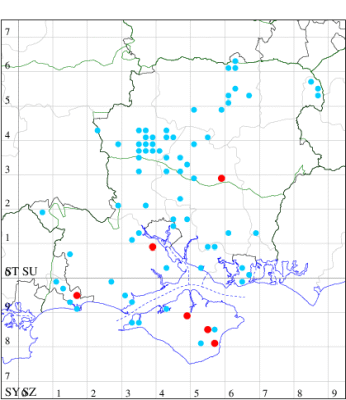
Records by year
Records by week (adult)
Records by week (larval)
Record Details
VC10: Newport*, one, 25 Jun; one, 14 Jul (DPl); Haseley Manor, one, 10 Jun (IOu);
VC11: Marchwood*, one, 22 Jun; one, 04 Jul (CTha); Burton, nr Christchurch, one, 29 Jul (JStw);
VC12: Hinton Ampner, one, 17 Jun (ASD)
63.022 [B&F: 1385] Anania crocealis (Hübner, 1796) - Local
Local in water meadows, marshes, river-banks and damp areas throughout much of England and Wales. The most likely confusion species is Udea lutealis, in which the cross-lines are more intricately sinuate, the stigmata are larger and clearly outlined, and there is a dark cloud in apex of hindwing [Goater]. Could also be mistaken for the extremely rare Paracorsia repandalis. Wingspan 22-25 mm. Larva feeds on Common Fleabane and Ploughman's-spikenard, living between leaves spun together with silk.
Records prior to 2022
| Vice County | #Records | #Individuals | First Record | Last Record |
|---|---|---|---|---|
| 10 | 117 | 111 | 1856 | 2021 |
| 11 | 389 | 351 | 1951 | 2021 |
| 12 | 93 | 100 | 1951 | 2021 |
2022 records
| Vice County | #Records | #Individuals | Max Quantity |
|---|---|---|---|
| 10 | 9 | 17 | 10 |
| 11 | 34 | 38 | 3 |
| 12 | 2 | 1 | 1 |
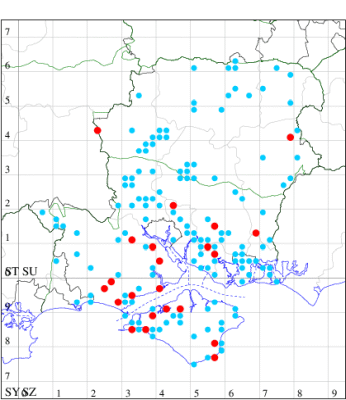
Records by year
Records by week (adult)
Records by week (larval)
Record Details
VC10: West High Down quarries, one, 12 Jul; East Afton Down, 10, field observation, 12 Jul (IOu); Cranmore, present, 15 Aug (CHic); one, 21 Jun (JMar, JRB et al); Walter's Copse, one, field observation, 01 Jun (SSib det. JRB); Parkhurst Forest, one, 02 Jul (IOu); Bonchurch, one, 17 Jun; one, 03 Aug (JHa); Shanklin, one, 03 Jul (IOu);
VC11: Marchwood, one, 10 Jul (CTha); Woodlands, NF, present, 17 Jun (RBW); Needs Ore NNR*, one, 09 Jul; three, 16 Jul (CNB); Dibden Purlieu*, one, 14 Jun (RAC); Allbrook, one, 12 Jul (SIng); Funtley, one, 15 Jun; one, 07 Jul; one, 09 Jul; one, 11 Jul; two, 13 Jul; one, 16 Jul; one, 18 Jul; one, 11 Aug; two, 24 Aug; three, 27 Aug; one, 28 Aug (TDC); Fareham, one, 25 Aug (MLO); one, 30 May (KJW); Shirrell Heath, one, 07 Jul (LEdg); Lovedean, one, 22 May; one, 16 Jun; one, 08 Jul; one, 11 Jul; one, 12 Jul (ARJ); Sway, one, 07 Jul (S&SLan); one, 11 Jul; one, 17 Jul; one, 18 Jul (SKee); Milford on Sea, one, 31 Jul (MMcM); Lymington, present, first date recorded , 27 Aug (PRD); Needs Ore NNR, one, 29 Jul; three, 18 Jun; one, 03 Jul; one, 21 Jul; one, 13 Aug; one, 19 Aug (CNB);
VC12: Cholderton*, present, 19 Jul (TJN); Blacknest*, one, 02 Aug (MAng)
63.023 [B&F: 1382] Anania verbascalis ([Denis & Schiffermüller], 1775) - Nationally Scarce B
Nationally scarce (Nb) in open areas where the foodplant grows, such as heaths and shingle beaches, in parts of southern England. In Hampshire and on the Isle of Wight chiefly confined to the New Forest and the coast, and distinctly uncommon in northern Hampshire. Wingspan 22-26 mm. The species has a characteristic bronze coloration which readily distinguishes it [Goater]. Larva feeds on Wood Sage.
Records prior to 2022
| Vice County | #Records | #Individuals | First Record | Last Record |
|---|---|---|---|---|
| 10 | 8 | 7 | 1856 | 2021 |
| 11 | 88 | 72 | 1907 | 2021 |
| 12 | 3 | 1 | 1951 | 2003 |
2022 records
| Vice County | #Records | #Individuals | Max Quantity |
|---|---|---|---|
| 10 | 1 | 1 | 1 |
| 11 | 7 | 12 | 4 |
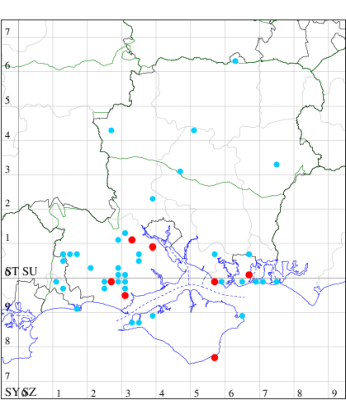
Records by year
Records by week (adult)
Records by week (larval)
Record Details
VC10: Bonchurch, one, 10 Jul (JHa);
VC11: Marchwood, one, 19 Jul (CTha); Woodlands, NF, one, 17 Jul (CJon); Portsmouth, one, 02 Jun (IRT); Sway, one, 18 Jul (SKee); Pennington, one, 20 Jul (RFC); Browndown Coastal Ranges, three, 08 Jul (RJD, ADT, DWal & KJW); four, 15 Jul (MLO, ADT, DWal & KJW)
63.025 [B&F: 1376] Small Magpie Anania hortulata (Linnaeus, 1758) - Common
Common wherever there are nettles, throughout southern England and locally in northern England and southern Scotland. Widespread and common in Hampshire and on the Isle of Wight. Wingspan 33-35 mm. One of the most distinctive and easily recognised British species of micro-moth. Larva feeds on both perennial and annual species of nettle, Stinging Nettle and Small Nettle.
Records prior to 2022
| Vice County | #Records | #Individuals | First Record | Last Record |
|---|---|---|---|---|
| 10 | 975 | 2334 | 1951 | 2021 |
| 11 | 7034 | 10895 | 1951 | 2021 |
| 12 | 3437 | 7046 | 1951 | 2021 |
2022 records
| Vice County | #Records | #Individuals | Max Quantity |
|---|---|---|---|
| 10 | 117 | 291 | 15 |
| 11 | 328 | 454 | 8 |
| 12 | 161 | 279 | 12 |

Records by year
Records by week (adult)
Records by week (larval)
Record Summary
VC10: Earliest: Alverstone, 20 May, 1 (DFai) Latest: Bonchurch, 14 Aug, 4 (JHa) Max count: Bonchurch, 09 Jul, 15 (JHa)
VC11: Earliest: West Walk, 28 Mar, 5 (RJD) Latest: Burton, nr Christchurch, 12 Aug, 1 (JStw) Max count: Romsey, 08 Jul, 8 (NRJ)
VC12: Earliest: Broughton, 10 May, 1 (GCE) Latest: Farnham, 12 Sep, 0 (iNat) Max count: Cholderton, 01 Jul, 12 (TJN)
63.027 [B&F: 1383] Psammotis pulveralis (Hübner, 1796) - Migrant
Immigrant to southern England from mainland Europe, arriving in some years in sufficient numbers to breed. In Hampshire and Isle of Wight, very irregular, although like many migrant species, occurences appear to be increasing. Wingspan 23-25 mm. Larva feeds on Water Mint and Gypsywort.
Records prior to 2022
| Vice County | #Records | #Individuals | First Record | Last Record |
|---|---|---|---|---|
| 10 | 5 | 6 | 2003 | 2018 |
| 11 | 4 | 2 | 1981 | 2016 |
2022 records
| Vice County | #Records | #Individuals | Max Quantity |
|---|---|---|---|
| 10 | 1 | 1 | 1 |
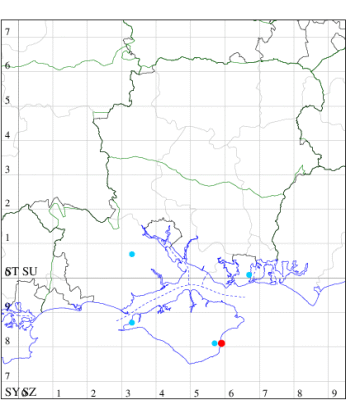
Records by year
Records by week (adult)
Records by week (larval)
Record Details
VC10: Shanklin Upper Chine, one, 19 Jul (IOu)
63.028 [B&F: 1375] European Corn-borer Ostrinia nubilalis (Hübner, 1796) - Local
Local on waste ground in south-east England, formerly a rare immigrant, subsequently becoming established in the Thames Valley and around Portsmouth, and now found throughout much of southern England. Widespread and fairly common in Hampshire and on the Isle of Wight. Wingspan 29-37 mm. Male is unmistakable; female can be confused with Sitochroa verticalis, but in that species the second line on forewing is evenly curved, not angled below half-way. Larva feeds in Britain on Mugwort, on the continent it is often a serious pest of Maize.
Records prior to 2022
| Vice County | #Records | #Individuals | First Record | Last Record |
|---|---|---|---|---|
| 10 | 246 | 403 | 1850 | 2021 |
| 11 | 1965 | 2569 | 1951 | 2021 |
| 12 | 437 | 669 | 1951 | 2021 |
2022 records
| Vice County | #Records | #Individuals | Max Quantity |
|---|---|---|---|
| 10 | 71 | 117 | 12 |
| 11 | 281 | 511 | 17 |
| 12 | 126 | 263 | 30 |

Records by year
Records by week (adult)
Records by week (larval)
Record Summary
VC10: Earliest: Freshwater Bay, 10 Jun, 1 (SDav) Latest: Freshwater, 20 Sep, 1 (PBar) Max count: Plaish, Carisbrooke, 20 Jul, 12 (KRyl)
VC11: Earliest: Marchwood, 04 Jun, 1 (CTha) Latest: Woodley, 03 Oct, 1 (NBin) Max count: Burton, nr Christchurch, 23 Aug, 17 (JStw)
VC12: Earliest: Blackwater, 11 Jun, 1 (BGD) Latest: Basingstoke, 03 Oct, 1 (MJW) Max count: Basingstoke, 18 Jul, 30 (MJW)
63.030 [B&F: 1374] Paratalanta hyalinalis (Hübner, 1796) - Nationally Scarce B
Nationally scarce (Nb) on chalk downland and in woodland clearings in parts of southern England. In Hampshire widespread across the chalk in the north of the county, and occasionally numerous, as at Micheldever Spoil Heaps in 2005 and Danebury in 1999, but distinctly uncommon in the south and on the Isle of Wight. Wingspan 28-35 mm. The most likely confusion species is Sitochroa verticalis, from which distinguished by the characteristic shape of the cross-lines. Larva feeds on Common Knapweed, Great Mullein and Stinging Nettle.
Records prior to 2022
| Vice County | #Records | #Individuals | First Record | Last Record |
|---|---|---|---|---|
| 10 | 10 | 11 | 1974 | 2014 |
| 11 | 56 | 80 | 1800 | 2021 |
| 12 | 41 | 106 | 1951 | 2020 |
2022 records
| Vice County | #Records | #Individuals | Max Quantity |
|---|---|---|---|
| 11 | 1 | 1 | 1 |
| 12 | 1 | 1 | 1 |

Records by year
Records by week (adult)
Records by week (larval)
Record Details
VC11: Old Winchester Hill, one, 05 Aug (RJD, MLO, ADT, DWal, KJW);
VC12: Basingstoke*, one, 14 Aug (MJW)










